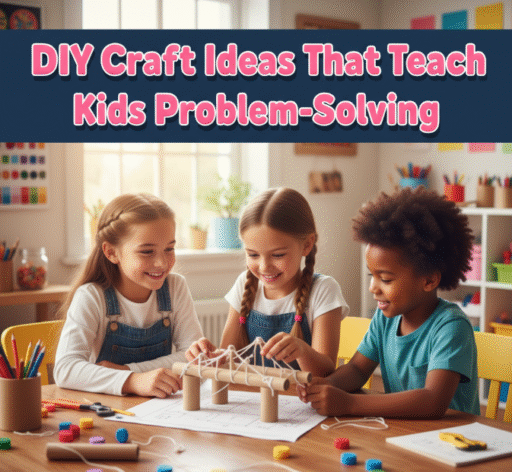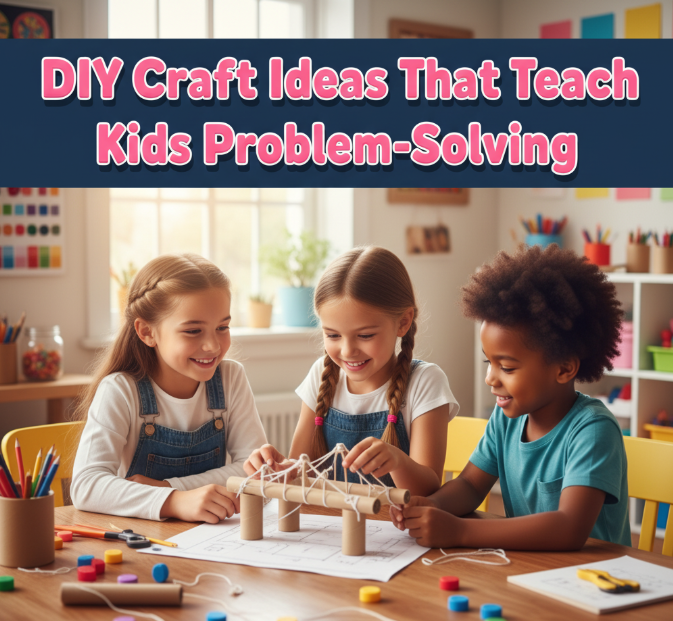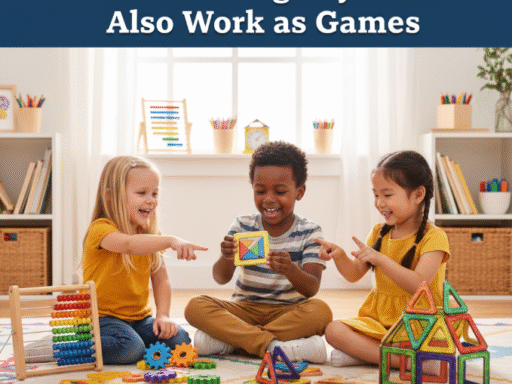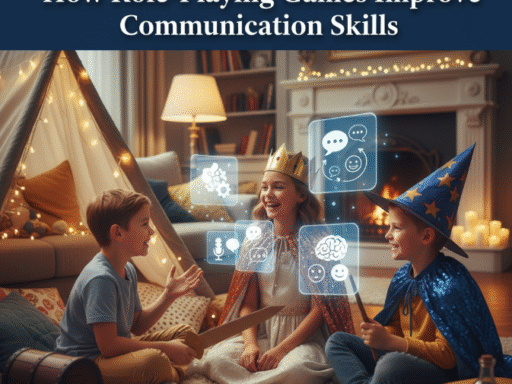Introduction: Why Problem-Solving Through Crafts Matters
Every parent or teacher wants children to grow up with strong thinking skills. But problem-solving is not just about math problems or puzzles—it’s about finding creative solutions in everyday life. One of the best ways to teach kids problem-solving is through DIY crafts.
Crafting encourages children to plan, experiment, and adjust. When kids cut, glue, fold, or design something, they learn to deal with mistakes, test different approaches, and think outside the box. This is exactly what problem-solving is all about.
In this article, we’ll explore fun and practical DIY craft ideas that challenge kids to think critically, improve motor skills, and boost creativity. Each idea comes with a breakdown of the skills kids learn while crafting.
How Crafts Build Problem-Solving Skills
Before diving into specific DIY ideas, let’s quickly look at why crafting is such a powerful problem-solving tool.
-
Encourages planning: Kids must decide what materials to use and how to assemble them.
-
Promotes decision-making: Choosing colors, shapes, or designs develops critical thinking.
-
Teaches patience and flexibility: If one method doesn’t work, kids try another.
-
Boosts creativity: Problem-solving often requires thinking differently.
-
Hands-on learning: Kids remember lessons better when they actively create something.
👉 In short, crafting transforms playtime into a brain-building activity.
DIY Craft Ideas That Develop Problem-Solving Skills
1. Paper Maze Challenge
What you need: Cardboard, straws, glue, scissors, and a small marble.
How to do it:
-
Glue straws onto a cardboard base to form a maze.
-
Leave an entry and exit point.
-
Drop the marble inside and let kids tilt the board to move it through.
Skills learned:
-
Strategic planning (designing the maze)
-
Spatial awareness
-
Trial-and-error problem-solving
📊 Quick Tip Table:
| Difficulty | Best Age Group | Main Skills Built |
|---|---|---|
| Easy | 5–10 years | Spatial thinking, patience |
2. Recycled Bottle Bridge
What you need: Plastic bottles, cardboard, tape, and string.
How to do it:
-
Line up plastic bottles to act as the floating base.
-
Tape cardboard across the top to make a bridge.
-
Test how much weight it can hold by placing small toys on it.
Skills learned:
-
Engineering basics
-
Weight distribution
-
Trial-and-error adjustments
This craft helps kids experiment with stability, just like real engineers.
3. Puzzle Piece Art
What you need: Old jigsaw puzzle pieces, glue, markers, and a cardboard base.
How to do it:
-
Ask kids to design a picture using puzzle pieces.
-
They must arrange and rearrange until it fits their vision.
Skills learned:
-
Logical reasoning
-
Patience
-
Creativity in problem-solving
4. Balloon-Powered Car
What you need: Straws, bottle caps, cardboard, balloon, tape, and skewers.
How to do it:
-
Cut cardboard into a car base.
-
Attach wheels using bottle caps and straws.
-
Fix a balloon at the back with a straw.
-
Blow air and release—it will zoom forward!
Skills learned:
-
Cause-and-effect understanding
-
Scientific problem-solving
-
Engineering creativity
5. Egg Drop Challenge
What you need: Eggs, straws, rubber bands, paper, and tape.
How to do it:
-
Build a “protective capsule” around the egg using available materials.
-
Drop it from a height and see if it survives.
Skills learned:
-
Critical thinking under constraints
-
Resource management
-
Innovation in problem-solving
This is a classic STEM-based activity that combines science with creativity.
6. Treasure Map Craft
What you need: Paper, tea bags (to make it look old), markers, and small treasures (coins, toys).
How to do it:
-
Create a treasure map with riddles and landmarks.
-
Hide treasures around the house or yard.
-
Let kids follow the map to solve clues.
Skills learned:
-
Sequential problem-solving
-
Reading and interpreting symbols
-
Logical reasoning
7. Straw Tower Building
What you need: Straws, tape, and paper.
How to do it:
-
Challenge kids to build the tallest tower that can stand without falling.
-
Allow them to redesign if it collapses.
Skills learned:
-
Structural problem-solving
-
Trial and error
-
Teamwork if done in groups
📈 Engagement Chart Example:
8. Origami Storytelling
What you need: Colored paper, markers.
How to do it:
-
Teach kids to fold origami animals.
-
Ask them to create a story using those animals.
Skills learned:
-
Sequential problem-solving (following folding steps)
-
Imaginative thinking
-
Communication skills
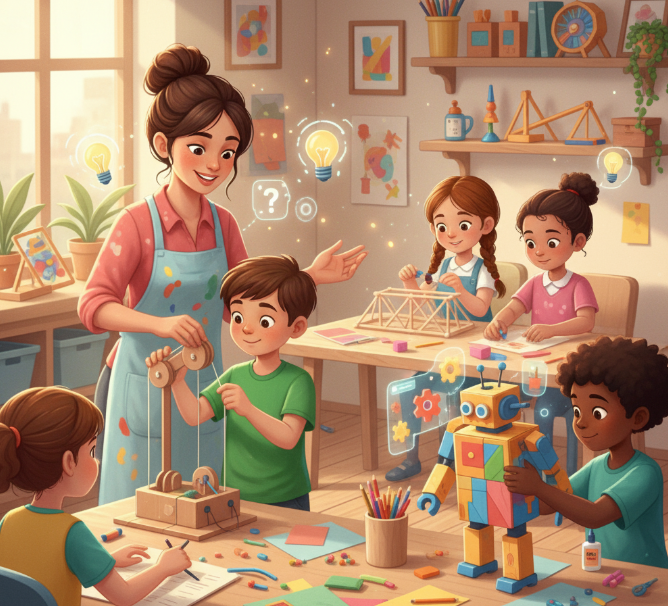
DIY Craft Ideas That Teach Kids Problem-Solving
9. DIY Shadow Puppet Theater
What you need: Cardboard box, paper, sticks, flashlight.
How to do it:
-
Cut out shapes of animals or characters.
-
Attach them to sticks.
-
Use a flashlight to cast shadows behind a screen.
Skills learned:
-
Creative storytelling
-
Problem-solving with light and shadows
-
Innovation
10. Marble Run
What you need: Toilet paper rolls, tape, cardboard, and marbles.
How to do it:
-
Attach paper rolls at different angles on a cardboard base.
-
Drop a marble from the top and watch it roll down.
-
Kids can redesign to make it faster or longer.
Skills learned:
-
Gravity and motion understanding
-
Critical design adjustments
-
Cause-and-effect problem-solving
11. Build Your Own Kite
What you need: Paper, string, sticks, and tape.
How to do it:
-
Construct a diamond-shaped frame with sticks.
-
Cover with paper and attach a string.
-
Test it outdoors.
Skills learned:
-
Aerodynamics basics
-
Patience and persistence
-
Creative engineering
12. Nature Collage with a Twist
What you need: Leaves, twigs, flowers, glue, and cardboard.
How to do it:
-
Collect different natural items.
-
Instead of gluing randomly, kids must arrange them into a shape (like an animal or tree).
Skills learned:
-
Problem-solving with limited resources
-
Pattern recognition
-
Creative design
13. LEGO Engineering Challenges
What you need: LEGO blocks or similar building sets.
How to do it:
-
Challenge kids to build a bridge, tower, or working machine.
-
Add problem-solving twists like weight limits or time restrictions.
Skills learned:
-
Engineering problem-solving
-
Creativity under constraints
-
Critical thinking
14. Mystery Box Craft
What you need: A shoebox, scissors, tape, and small random objects.
How to do it:
-
Place a random set of items inside the box.
-
Ask kids to create something useful out of them.
Skills learned:
-
Resourcefulness
-
Thinking outside the box
-
Innovation
15. DIY Rube Goldberg Machine
What you need: Dominoes, marbles, cardboard ramps, toy cars.
How to do it:
-
Kids design a machine where one action triggers another.
Example: Marble rolls → hits dominoes → pushes car → pops balloon.
Skills learned:
-
Sequential problem-solving
-
Cause-and-effect
-
Engineering creativity
Comparing Craft Ideas by Skills
| Craft Idea | Main Skill Focus | Fun Level |
|---|---|---|
| Paper Maze | Logical thinking | ★★★★☆ |
| Bottle Bridge | Engineering basics | ★★★★☆ |
| Egg Drop Challenge | Critical problem-solving | ★★★★★ |
| Treasure Map | Sequential reasoning | ★★★★☆ |
| Rube Goldberg Machine | Complex problem-solving | ★★★★★ |
Tips to Make DIY Problem-Solving Crafts More Effective
-
Encourage mistakes: Let kids fail and try again—it’s part of the process.
-
Ask guiding questions: Instead of giving answers, ask “What else could you try?”
-
Provide limited resources: This forces creative problem-solving.
-
Celebrate effort, not just results: Focus on the thinking, not perfection.
Conclusion: Turning Crafts into Life Lessons
DIY crafts are more than just fun activities—they’re mini-problem-solving workshops for kids. Whether it’s building a marble run, designing a balloon-powered car, or protecting an egg from breaking, each project encourages children to think critically, test solutions, and learn from mistakes.
By introducing these crafts at home or in the classroom, parents and teachers can help kids develop skills that will benefit them in school, careers, and everyday life.
So, gather some cardboard, tape, and imagination—and let your kids discover the joy of creative problem-solving through crafts!
